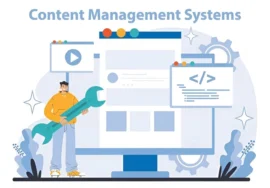
Choosing a Back-End Language: PHP, Python, Node.js, and Beyond – Unveiling the Perfect Fit for Your Project
The captivating world of web development thrives on the dynamic interplay between the visible front end and the robust back end. While users revel in the aesthetics and interactivity of a website or application, the backdrop orchestrates the magic behind the scenes. Here, intricate logic, data manipulation, and server-side communication reign supreme. But for developers, embarking on a new project asks a crucial question: which back-end language should they choose?
This comprehensive guide delves into the realm of popular back-end languages, dissecting the strengths and considerations of PHP, Python, Node.js, and other contenders. By equipping you with insightful analysis, we aim to empower you to make an informed decision that aligns with your project’s specific requirements.
The Back-End Symphony: Understanding Its Significance
The back end acts as the invisible backbone of any web application. It’s the maestro of the digital orchestra, conducting a symphony of tasks:
- Data Management: At the heart of functionality lies data. The back-end language interacts with databases, storing, retrieving, and manipulating critical information that fuels the application.
- Server-Side Logic: Complex calculations, business rules, and user authentication all live within the back-end domain. It dictates how the application responds to user actions and external stimuli.
- API Communication: Modern applications often interact with various external services. The back-end language facilitates these interactions through robust Application Programming Interfaces (APIs).
The language you choose for your back-end development impacts factors like development speed, scalability, maintainability, and the overall success of your project.
The Contenders: Unveiling the Back-End Powerhouses
The back-end development landscape boasts a diverse array of languages, each with its own unique advantages and considerations. Let’s delve into the most prominent contenders:
PHP: The Veteran Warrior
- Strengths: PHP (Hypertext Preprocessor) has reigned supreme for decades, lauded for its:
- Ease of Use: Its simple syntax makes it approachable for beginners.
- Large Community: A vast community of developers translates to abundant resources and troubleshooting support.
- Mature Frameworks: Frameworks like Laravel and CodeIgniter offer pre-built functionalities, accelerating development.
- Considerations: While robust, PHP might not be the most innovative choice for complex projects. Its code structure can sometimes become cumbersome for large-scale applications.
Python: The Versatile Powerhouse
- Strengths: Python’s meteoric rise in popularity stems from its:
- Readability: Its clear and concise syntax fosters code that is easy to understand and keep.
- Versatility: Python extends beyond web development, excelling in data science and machine learning.
- Powerful Frameworks: Frameworks like Django and Flask streamline development while offering exceptional scalability.
- Considerations: While Python is beginner-friendly, its dynamic typing can present challenges for larger codebases with strict checking requirements.
Node.js: JavaScript Full Stack
- Strengths: Node.js revolutionized the back-end by enabling JavaScript to run on the server side. This translates to:
- Unified Development: Developers familiar with JavaScript can leverage their existing skills for both front-end and back-end development.
- Real-Time Excellence: Node.js excels in real-time applications due to its event-driven, non-blocking architecture.
- Rich Ecosystem: A thriving Node Package Manager (NPM) offers a vast array of pre-built modules and libraries.
- Considerations: While asynchronous programming offers advantages, it can introduce a steeper learning curve for developers accustomed to traditional synchronous coding styles.
Beyond the Big Three: Exploring Additional Back-End Languages
The realm of back-end development extends beyond the dominant trio of PHP, Python, and Node.js. Here are some noteworthy languages that deserve exploration:
Java: The Enterprise Stalwart
- Strengths: Java is synonymous with enterprise-level applications, boasting:
- Maturity and Stability: Its long-standing presence translates to a robust ecosystem and a wealth of resources.
- Scalability: Java applications can scale seamlessly to accommodate massive user bases and complex functionalities.
- Object-Oriented Design: Java’s core principles promote well-structured and maintainable code.
- Considerations: Java’s verbosity can make it less beginner-friendly compared to Python or JavaScript. Additionally, compilation adds an extra step to the development process.
Ruby on Rails: The Agile Champion
- Strengths: Ruby on Rails (often simply referred to as Rails) prioritizes developer happiness with its:
- Convention Over Configuration (CoC): Rails enforces a structured approach, reducing boilerplate code and streamlining development.
- Rapid Prototyping: The Rails framework excels at getting projects off the ground quickly, ideal for validating ideas and launching Minimum Viable Products (MVPs).
- Active Community: A vibrant community fosters a wealth of resources and support for Rails developers.
- Considerations: Rails’ opinionated nature might not suit projects requiring a high degree of customization. Additionally, the talent pool for Ruby developers might be smaller compared to some other languages.
Go: The Concurrency Contender
- Strengths: Developed by Google, Go offers unique advantages for specific use cases:
- Concurrency and Performance: Go excels in handling concurrent requests efficiently, making it ideal for highly scalable web applications.
- Statically Typed: Go’s static typing ensures a stricter code structure and helps catch errors early in the development process.
- Simple and Clean Syntax: Go prioritizes readability and maintainability with its clear and concise syntax.
- Considerations: The Go ecosystem is still evolving compared to more established languages. Finding experienced Go developers might be more challenging.
C#: .NET Powerhouse**
- Strengths: C# is the backbone of the .NET framework, offering:
- Rich Ecosystem: The .NET framework provides a comprehensive set of libraries and tools for various development needs.
- Cross-Platform Compatibility: C# code can be written for various platforms beyond web development, including mobile and desktop applications.
- Strong Typing: Similar to Go, C#’s static typing enforces code structure and improves maintainability.
- Considerations: The learning curve for C# and the .NET framework might be steeper compared to some scripting languages. Additionally, certain functionalities might require Windows-specific tools.
Choosing the Right Back-End Language: A Strategic Decision
Having explored these diverse languages, it’s time to make the crucial decision of selecting the ideal back-end language for your project. Here are some key factors to consider:
- Project Requirements: Carefully analyze the application’s complexity, scalability needs, and real-time interactions.
- Team Expertise: Leveraging your team’s existing skills can streamline development and foster better collaboration.
- Community and Resources: A larger community translates to more resources, tutorials, and troubleshooting assistance.
- Learning Curve: If time is a constraint, prioritize languages known for readability and ease of use.
- Scalability Needs: Consider if the language can accommodate potential future growth in terms of users and data.
- Performance Requirements: For applications requiring exceptional speed or handling massive data sets, specific languages might be better suited.
Ultimately, the “best” back-end language isn’t a one-size-fits-all answer. By meticulously evaluating your project’s needs and strategically considering these factors, you can make an informed decision that empowers your development team and propels your project toward success.





